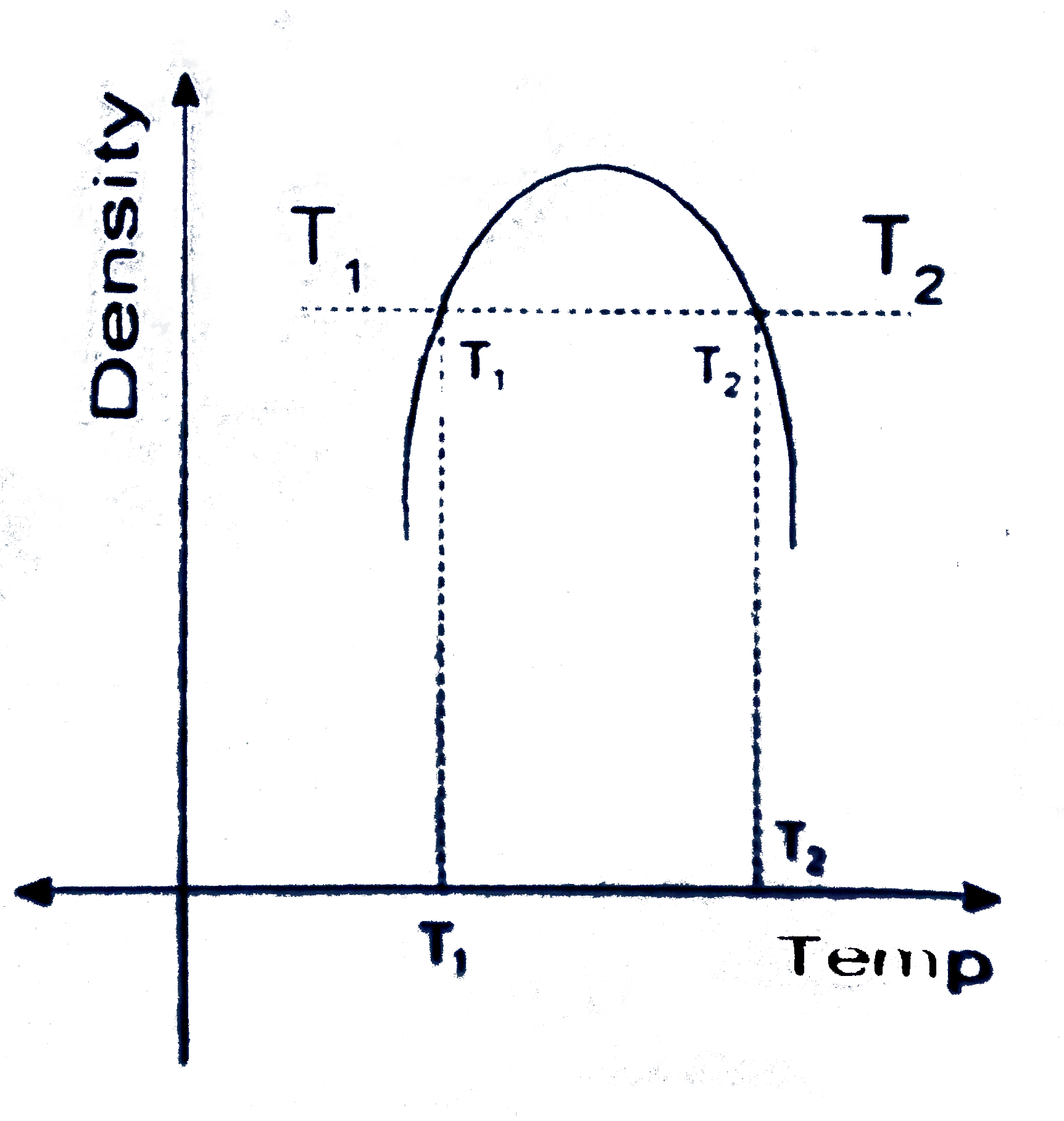Two bolcks to the same metal having same mass and at temperature T1 and T2 respectively ,are brought in contact with each other and allowed to attain thermal equilibrium at constant pressure .The change in entropy ,ΔS for this process is :
2Cp In[T1+T22T1T2]
2Cp In [T1+T24T1T2]
2Cp In ⎡⎢⎣(T1+T2)12T1T2⎤⎥⎦
Cp In [(T1+T2)24T1T2]
The correct Answer is:D
To solve the problem of finding the change in entropy, ΔS, when two blocks of the same metal with the same mass at temperatures T1 and T2 are brought into contact, we can follow these steps:
Step 1: Understand the System
We have two blocks of the same metal, both with mass m, at temperatures T1 and T2. When they come into contact, they will exchange heat until they reach thermal equilibrium at a final temperature Tf.
Step 2: Apply the Principle of Conservation of Energy
The initial energy of the system must equal the final energy. Therefore, we can write:
mCvT1+mCvT2=2mCvTf
Where Cv is the specific heat capacity at constant volume. Since the masses and Cv are the same for both blocks, we can simplify the equation:
T1+T2=2Tf
From this, we can solve for the final temperature:
Tf=T1+T22
Step 3: Calculate the Change in Entropy for Each Block
The change in entropy for each block can be calculated using the formula:
ΔS=Cpln(TfTi)
Where Cp is the specific heat capacity at constant pressure.
For the first block:
ΔS1=Cpln(TfT1)
For the second block:
ΔS2=Cpln(TfT2)
Step 4: Total Change in Entropy
The total change in entropy for the system is the sum of the changes in entropy for both blocks:
ΔS=ΔS1+ΔS2
Substituting the expressions from Step 3:
ΔS=Cpln(TfT1)+Cpln(TfT2)
This can be combined using the properties of logarithms:
ΔS=Cp(ln(TfT1)+ln(TfT2))=Cpln⎛⎝T2fT1T2⎞⎠
Step 5: Substitute Tf
Now we substitute Tf=T1+T22 into the equation:
ΔS=Cpln⎛⎜
⎜⎝(T1+T22)2T1T2⎞⎟
⎟⎠
This simplifies to:
ΔS=Cpln((T1+T2)24T1T2)
Final Result
Thus, the final expression for the change in entropy is:
ΔS=Cpln((T1+T2)24T1T2)
We have two blocks of the same metal, both with mass m, at temperatures T1 and T2. When they come into contact, they will exchange heat until they reach thermal equilibrium at a final temperature Tf.
The initial energy of the system must equal the final energy. Therefore, we can write:
mCvT1+mCvT2=2mCvTf
Where Cv is the specific heat capacity at constant volume. Since the masses and Cv are the same for both blocks, we can simplify the equation:
T1+T2=2Tf
From this, we can solve for the final temperature:
Tf=T1+T22
The change in entropy for each block can be calculated using the formula:
ΔS=Cpln(TfTi)
Where Cp is the specific heat capacity at constant pressure.
ΔS1=Cpln(TfT1)
ΔS2=Cpln(TfT2)
The total change in entropy for the system is the sum of the changes in entropy for both blocks:
ΔS=ΔS1+ΔS2
Substituting the expressions from Step 3:
ΔS=Cpln(TfT1)+Cpln(TfT2)
This can be combined using the properties of logarithms:
ΔS=Cp(ln(TfT1)+ln(TfT2))=Cpln⎛⎝T2fT1T2⎞⎠
Now we substitute Tf=T1+T22 into the equation:
ΔS=Cpln⎛⎜
⎜⎝(T1+T22)2T1T2⎞⎟
⎟⎠
This simplifies to:
ΔS=Cpln((T1+T2)24T1T2)
Thus, the final expression for the change in entropy is:
ΔS=Cpln((T1+T2)24T1T2)
Topper's Solved these Questions
Similar Questions
Two bodies A and B are said to be in thermal equilibrium with each other if they have same
View SolutionTwo vessels of volume (V1)and(V2) contain the same ideal gas. The pressures in the vessels are (P1)and(P2) and the temperatures are (T1)and(T2) respectively . The two vessels are now connected to each other through a narrow tube. Assuming that no heat is exchanged between the surrounding and the vessels, find the common pressure and temperature attained after the connection.
View Solution
Knowledge Check
Two cylinder having m1g and m2g of a gas at pressure P1 and P2 respectively are put in cummunication with each other, temperature remaining constant. The common pressure reached will be
AP1P2(m1+m2)P2m1+P1m2BP1P2m1P2m1+P1m2Cm1m2(P1+P2)P2m1(P1+P2)Dm1m2P2P2m1+P1m2For a given exothermic reaction ,KPandKp' are the equilibrium constant at temperature T1andT2 respectively .Assuming that heat of reaction is constant in temperature range between T1andT2 , it is readly observed that
AKp>KpBKp<KpCKp=KpDKp=1Kp'
Two containers of equal volume contain the same gas at pressure P1 and P2 and absolute temperature T1 and T2, respectively. On joining the vessels, the gas reaches a common pressure P and common temperature T. The ratio P/T is equal to
View SolutionTwo containers of equal volume contain the same gas at pressure P1 and P2 and absolute temperature T1 and T2, respectively. On joining the vessels, the gas reaches a common pressure P and common temperature T. The ratio P/T is equal to
View SolutionTwo bodies of different temperatures T1andT2 if brought in thermal contact, do not necessarily settle to the mean temperature (T1+T2)/2. Why?
View SolutionTwo identical containers A and B having same volume of ideal gas at the same temperature have mass of the gas as mA and mB respectively. 2mA=3mB. The gas in each cylinder expand isothermally to double its volume. If the change in pressure in A is Δp, find the change in pressure in B:
View SolutionTwo identical systems, with heat capacity at a constant volume that varies as Cv=bT3 (where b is a constant) are thermally isolated. Initially, one system is at a temperature 100 K and the other is at 200K. The systems are then brought to thermal contact and the combined system is allowed reach thermal equilibrium. If T40=n×108 then what will be the value of n, where T0 is the final temperature in kelvin?
View SolutionA thermometer uses density of water as thermometric property. Actual reading in thermometer is height of water (h) which inversely proportional to the density of water (d). In certain temp range is symmetrical ablout maximum.
Two identical bodies (of same mass and specific heat) at different temp T1 and T2 show the same reading of height h1=h2 in the thermometer. The bodies are brought in contact and allowed to reach the equilibrium. The thermometric reading height of water for final equilibrium state hf satisfies

View Solution
